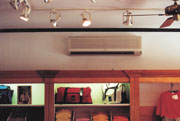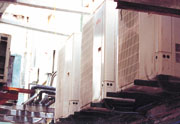
Stuart Randles, of Cool Air Bermuda Ltd., knows about the opportunities ductless mini-splits can provide contractor and customer. One customer was even able to utilize the store’s existing ductwork with the ductless systems.
The contractor says he started using Fujitsu ductless mini-splits over two years ago. In that time, his company has installed more than 250 ductless systems on the island of Bermuda.
Randles says his company tries to provide its customers with what they request; ductless mini-splits are often the solution to what a consumer is looking for when it comes to climate control.
One such example is an application Randles was involved in last year. Cool Air installed ductless mini-splits at Archie Brown, a three-story department store in Hamilton, Bermuda.
Randles says the installation was a success, having met a variety of the owner’s needs.

THE DUCTLESS CHOICE
According to Randles, the department store’s original system consisted of two 15-year-old, 7.5-ton condensing units, and a two-stage air handler.The owner of the building had some specific desires for the new system. One of the main requests was to keep costs down. This included the installation cost as well as energy costs.
Randles points out that the appearance of the system was a factor. Taking all of this into account, the contractor says he decided to propose a ductless mini-split system.
The company chose to install Fujitsu’s 30C1 ductless units to provide cooling only. By using these systems, Randles says, future energy costs could be lower.
He explains that ductless systems allow consumers to have more control over the amount of cooling they need in specific areas. When cooling needs are lower, units can be turned down or turned off, thus reducing energy use and energy costs.
GET CREATIVE
The installation also allowed Randles to keep the cost of the job down, which in turn kept the cost down for the customer. Part of this, according to Randles, had to do with being creative with the installation.“It took just over a week,” Randles said about the work. “It was quite easy, but it’s based on how creative your engineers are.”
The contractor explains that his company decided to take advantage of the department store’s existing ductwork. “The ducts ran along one side of the building,” he explains. “We utilized the ductwork for the Fujitsu units.”
Randles further explains that the outside units were mounted on the side of the department store in the alleyway. The indoor ductless systems were then placed on the side of the building with the ductwork. Technicians took advantage of the existing registers and placed the indoor units on top of them.
Randles believes that more contractors should take advantage of the benefits ductless mini-splits can provide. He says that going ductless can be a good profit maker when all of the pieces fit together.
If the needs of a customer can be fulfilled with ductless units — even by using existing ductwork to do so — and the design of the system can accommodate the location, Randles says ductless is the way to go.
Publication date: 06/17/2002


Report Abusive Comment